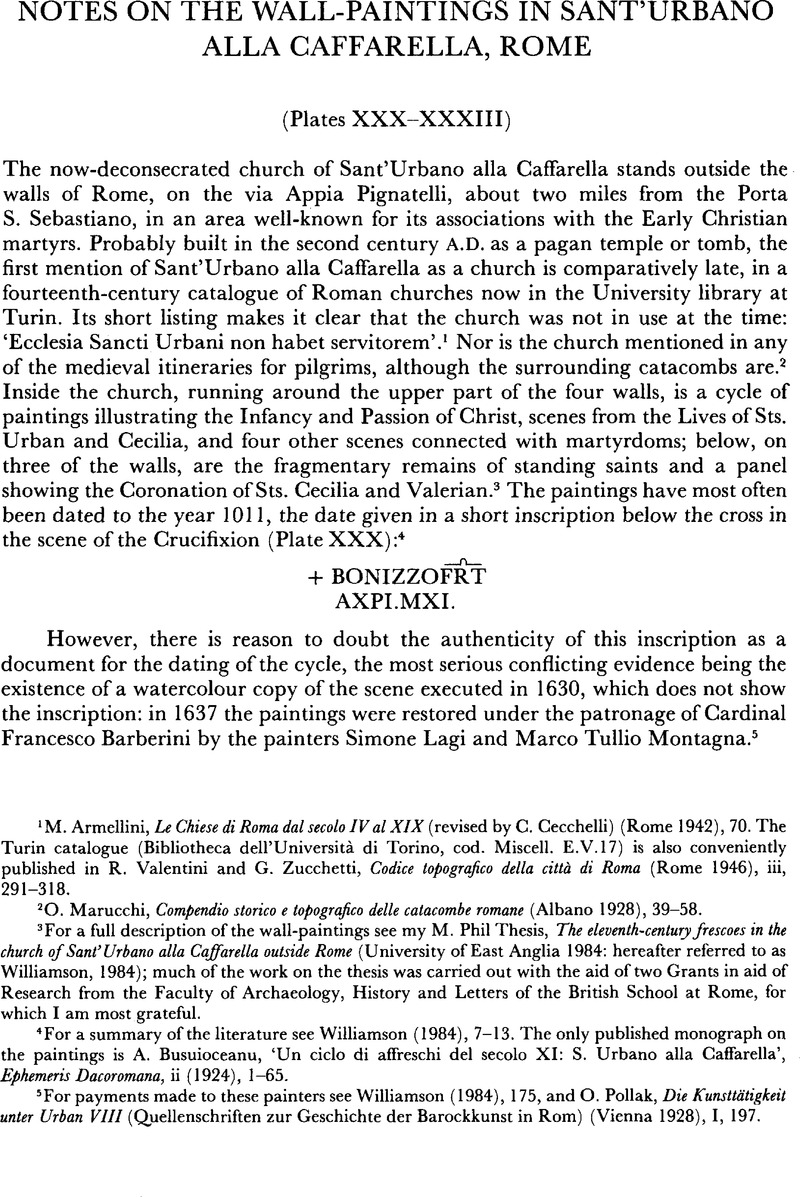Article contents
Notes on the Wall-Paintings in Sant'urbano alla Caffarella, Rome
Published online by Cambridge University Press: 09 August 2013
Abstract

- Type
- Articles
- Information
- Copyright
- Copyright © British School at Rome 1987
References
1 Armellini, M., Le Chiese di Roma dal secolo IV al XIX (revised by Cecchelli, C.) (Rome 1942), 70Google Scholar. Turin catalogue (Bibliotheca dell'Università di Torino, cod. Miscell. E.V.17) is also conveniently published in Valentini, R. and Zucchetti, G., Codice topografico della città di Roma (Rome 1946), 291–318Google Scholar.
2 Marucchi, O., Compendia storico e topografico delle catacombe romane (Albano 1928), 39–58Google Scholar.
3 For a full description of the wall-paintings see my M. Phil Thesis, The eleventh-century frescoes in church of Sant'Urbano alia Caffarella outside Rome (University of East Anglia 1984Google Scholar: hereafter referred Williamson, 1984); much of the work on the thesis was carried out with the aid of two Grants in aid of Research from the Faculty of Archaeology, History and Letters of the British School at Rome, for which I am most grateful.
4 For a summary of the literature see Williamson (1984), 7–13. The only published monograph on the paintings is Busuioceanu, A., ‘Un ciclo di affreschi del secolo XI: S. Urbano alia Caffarella’, Ephemeris Dacoromana, ii (1924), 1–65Google Scholar.
5 For payments made to these painters see Williamson (1984), 175, and Pollak, O., Die Kunsttätigkeit unter Urban VIII (Quellenschriften zur Geschichte der Barockkunst in Rom) (Vienna 1928), I, 197Google Scholar.
6 Waetzoldt, S., Die Kopien des 17. Jahrhunderts nach Mosaiken und Malereien in Rom (Vienna 1964), 75–6Google Scholar.
7 Williamson (1984), 7–8, 24, 173–5.
8 Ibid, fig. 54.
9 Ibid, figs. 47–8.
10 For a full set of illustrations of this series see Waetzoldt (1964), figs. 561–94.
11 Waetzoldt (1964), 20.
12 Busuioceanu (1924), 3, considered that the manuscript cod. Barb. lat. 4402 ‘non presenta alcun interesse per lo studio del monumento’. Waetzoldt (1964), 78, pointed out that the Eclissi watercolour showed the Crucifixion scene without the inscription, but nevertheless accepted the date of 1011 for the paintings.
13 This incident is described in John, XIX, 23–25, but in that account there are four soldiers. In Matthew,, XXVII, 35, and Mark, XV, 24, the number of soldiers is not specified.
14 Codex Egberti (facsimile, Basel 1960), folio 83v; Morisani, O., Gli affreschi di S. Angelo in Formis (Cava dei Tirreni 1962)Google Scholar, pls. 44, 47.
15 Garrison, E. B., Studies in the History of Medieval Italian Painting, iv (Florence 1962)Google Scholar, fig. 121.
16 Busuioceanu (1924), 8–9.
17 For Bonizzo of Sutri see Berschin, W., Bonizzo von Sutri, Leben und Werk (Berlin 1972)Google Scholar; other late eleventh-century Bonizzos are mentioned in the Pontificate, Liber (Duchesne, L. (ed.), Liber Pontificalis (Paris 1955), ii, 282)Google Scholar, and elsewhere (Williamson (1984), 139, n. 136).
18 The date of around 1090 is argued for at length in Williamson (1984), passim: a detailed discussion of the style and iconography of the cycle falls outside the scope of the present note. It should be noted that there was certainly a great interest in St. Urban under Pope Urban II (1088–99).
19 Matthiae, G., Pittura Romana del Medioevo, i (Rome 1965)Google Scholar, pl. 141.
20 Acta Sanctorum, Augusti, II, 124–42 (Sixtus and followers), 485–532 (Lawrence): the episode of Sixtus and Lawrence at the catacomb of Praetextatus is recounted on p. 141.
21 De Rossi, G. B., La Roma Sotterranea Cristiana (Rome 1864–1877), ii, 87–98Google Scholar; Northcote, J. S. and Brownlow, W. R., Roma Sotterranea (London 1879), i, 140–1Google Scholar, fig. 16; Styger, P., Die römischen Katakomben: archáologische Forschungen über den Ursprung und die Bedeutung der altchristlichen Grabstätten (Berlin 1933), 154–64Google Scholar.
22 The position of the cubiculum in the catacomb can be seen in the map published by Nestori, A., Repertorio topografico delle pitture delle catacombe romane (Vatican City 1975)Google Scholar, fig. 20.
23 Parker, J. H., The Archaeology of Rome, xii, The Catacombs (Oxford-London 1877), 76–86Google Scholar, pl. IX.
24 For the Life of St. Urban and his connections with the catacomb of Praetextatus see Williamson (1984), 19–23. There remain two further scenes of martyrdom at Sant'Urbano alia Caffarella which have yet to be identified.
- 1
- Cited by


